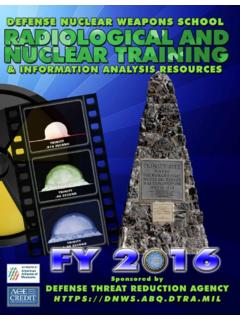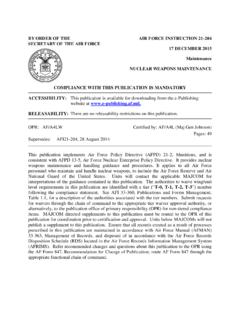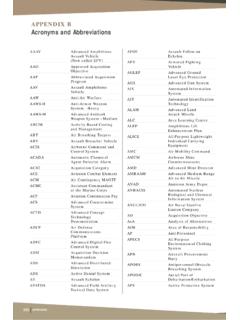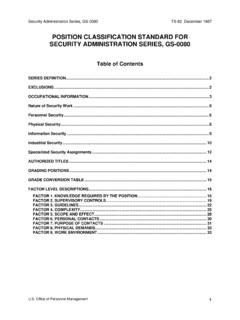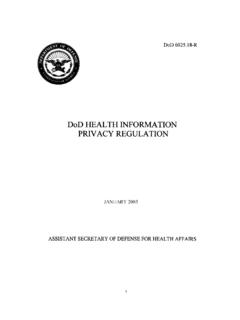Transcription of BY ORDER OF THE AIR FORCE INSTRUCTION 91-101 …
1 BY ORDER OF THE SECRETARY OF THE AIR FORCE AIR FORCE INSTRUCTION 91-101 15 AUGUST 2014 Incorporating Change 3, 27 April 2016 Safety AIR FORCE nuclear weapons SURETY PROGRAM COMPLIANCE WITH THIS PUBLICATION IS MANDATORY ACCESSIBILITY: Publications and forms are available on the e-Publishing website at for downloading or ordering. RELEASABILITY: There are no releasability restrictions on this publication. OPR: AFSEC/SEWN Supersedes: AFI 91-101 , 13 October 2010 Certified by: AF/SED (Mr. James T. Rubeor) Pages: 40 This INSTRUCTION implements Air FORCE Policy Directive (AFPD) 91-1, nuclear weapons and Systems Surety. This publication is consistent with AFPD 13-5, Air FORCE nuclear Enterprise. It outlines general responsibilities for the Air FORCE nuclear weapons Surety Program and defines implementing requirements.
2 This INSTRUCTION applies to all Air FORCE personnel, nuclear certified equipment, and facilities involved with nuclear weapons , nuclear weapon systems, and radioactive materials-related programs. Personnel involved with nuclear weapons , nuclear weapon systems, and 91(B) radioactive materials are responsible for compliance. This INSTRUCTION is applicable to the Air FORCE Reserve Command (AFRC) and Air National Guard (ANG) units performing nuclear missions. Send major command (MAJCOM) supplements to AMC/A3N, 402 Scott Drive, Unit 3A1, Scott AFB, IL, 62225-5302 or by email to and AFSEC/SEWN, 9700 G Avenue SE, Kirtland AFB NM 87117-5670, for coordination before publication. Ensure all records created as a result of processes prescribed in this publication are maintained in accordance with Air FORCE Manual (AFMAN) 33-363, Management of Records, and disposed of in accordance with Air FORCE Records Information Management System (AFRIMS) Records Disposition Schedule (RDS).
3 The authorities to waive wing/unit level requirements in this publication are identified with a Tier ( T-0, T-1, T-2, T-3 ) number following the compliance statement. See Air FORCE INSTRUCTION (AFI) 33-360, Publications and Forms Management, Table for a description of the authorities associated with the Tier numbers. Submit requests for waivers through the chain of command to the appropriate Tier waiver approval authority, or alternately, to the Publication Office of Primary Responsibility (OPR) for non-tiered compliance items. Refer recommended Certified Current on 10 July 20172 AFI91-101 15 AUGUST 2014 changes and questions about this publication to the OPR using the AF Form 847, Recommendation for Change of Publication; route AF IMTs 847 from the field through the appropriate functional s chain of command.
4 SUMMARY OF CHANGES This interim change revises AFI 91-101 by (1) updating lightning protection system program criteria IAW DoD , DoD nuclear Weapon System Safety Program Manual, (2) changes all PRP references to Personal Reliability Assurance Program (PRAP) per DoDM 13-501, nuclear weapons Personnel Reliability Program requirements, and (3) updates the sole vouching authority definition in Attachment 1 IAW policy guidance in DoD AFMAN 31-108, Volume 2, General nuclear Weapon Security Procedures. A margin bar (|) indicates newly revised material. Chapter 1 PROGRAM INFORMATION 4 Goal.. 4 nuclear weapons Surety (also referred to as nuclear Surety).. 4 Surety Standards.. 4 Chapter 2 RESPONSIBILITIES 5 Commanders /Directors Emphasis.
5 5 Headquarters United States Air FORCE (HQ USAF): .. 7 Major Commands (MAJCOMs), Field Operating Agencies (FOAs), and Direct .. 9 Air FORCE Materiel Command (AFMC) Commander.. 11 United States Air Forces in Europe (USAFE) Commander : .. 12 Air Education and Training Command (AETC) commander.. 13 MAJCOM weapons Safety Officer: .. 13 Numbered Air FORCE (NAF) weapons Safety Managers (WSMs): .. 14 Installation/Wing Commanders: .. 14 Installation Staff Officers:.. 15 Unit/Squadron Commanders:.. 16 Supervisors: .. 16 Individuals: .. 17 Wing/Base Level Weapon Safety Managers: .. 17 Unit Safety Representatives (USR): .. 19 AFI91-101 15 AUGUST 2014 3 Wing/Base nuclear Surety Council: .. 19 Joint Basing: .. 19 Chapter 3 SPECIAL nuclear SURETY POLICY AND GUIDANCE WAIVER PROCESS 20 Purpose.
6 20 Scope/Applicability.. 20 General.. 20 Functional Responsibilities.. 20 Deviations and Categories.. 22 Compensatory Measures.. 22 Deviation Submission/Cancellation Process.. 23 Deviations to nuclear Safety Design and Evaluation Criteria.. 23 Risk Management.. 24 Annual Reporting.. 24 Attachment 1 GLOSSARY OF REFERENCES AND SUPPORTING INFORMATION 26 Attachment 2 nuclear SURETY AUGMENTATION PROGRAM 40 4 AFI91-101 15 AUGUST 2014 Chapter 1 PROGRAM INFORMATION Goal. The goal of the Air FORCE nuclear weapons Surety Program is to incorporate maximum nuclear surety, consistent with operational requirements, from weapon system development to dismantlement. nuclear weapons Surety (also referred to as nuclear Surety).
7 Policies, procedures, controls, and actions that encompass safety, security, and control measures, which ensure there will be no nuclear weapons accidents, incidents, unauthorized detonation, or degradation of weapon effectiveness during its Stockpile-to-Target Sequence (STS). Surety Standards. The Air FORCE nuclear weapons Surety Program ensures personnel design and operate nuclear weapons and nuclear weapon systems to satisfy the safety standards in Department of Defense (DoD) Directive , DoD nuclear weapons Surety Program. The four DoD nuclear surety standards are: There shall be positive measures to prevent nuclear weapons involved in accidents or incidents, or jettisoned weapons , from producing a nuclear yield. There shall be positive measures to prevent DELIBERATE prearming, arming, launching, or releasing of nuclear weapons , except upon execution of emergency war orders or when directed by competent authority.
8 There shall be positive measures to prevent INADVERTENT prearming, arming, launching, or releasing of nuclear weapons in all normal and credible abnormal environments. There shall be positive measures to ensure adequate security of nuclear weapons , as governed by DoDD , Security Policy for Protecting nuclear weapons . AFI91-101 15 AUGUST 2014 5 Chapter 2 RESPONSIBILITIES Commanders /Directors Emphasis. Commanders at all levels are responsible for the success of the Air FORCE nuclear weapons Surety Program. Commanders MUST emphasize that safety, security, control, and effectiveness of nuclear weapons are of great importance to the United States. The following is not an all-inclusive list of restrictions dealing with nuclear weapons .
9 Commanders shall review the Weapon System Safety Rules (WSSRs) for their specific weapon system(s) found in AFIs 91-111 thru 91-117. (T-1) Do not use nuclear weapons to troubleshoot faults, that is, to confirm a fault exists, to aid in fault isolation, or to verify fault correction. AFI 91-107, Design, Evaluation, Troubleshooting, and Maintenance Criteria for nuclear Weapon Systems, contains specific guidance. (T-1) During exercises, do not wear complete chemical ensembles when handling war reserve nuclear weapons . Remove the gas mask, to aid in personal identification, and gloves, to ensure weapons are not inadvertently damaged. (T-1) Storing nuclear weapons in one facility and conventional munitions in another facility within the same weapons storage area (WSA) is not considered simultaneous presence and does not require MAJCOM approval.
10 Conventional munitions inherently part of a nuclear weapon system and/or nuclear weapon component ( , forward shroud, forward section, electrical explosive devices, and limited life components) located in the same assembly, surveillance, and inspection (AS&I)/maintenance and inspection (M&I), vault or storage facility are not considered simultaneous presence. Examples of conventional munitions include Mk82, Mk84, and Massive Ordnance Penetrator (MOP). Do not store nuclear weapons and conventional munitions together, except: (T-1) As part of flightline or protective aircraft shelter operations conducted IAW WSSRs. (T-1) The MAJCOM/CC may approve the temporary storage of nuclear and conventional munitions within a WSA facility to facilitate the warehousing of these materials in ORDER to meet immediate operational requirements.










